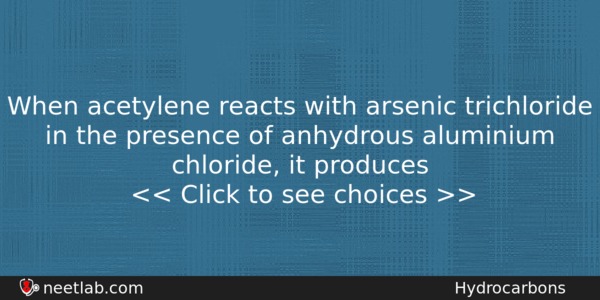| ⇦ | 
| ⇨ |
When acetylene reacts with arsenic trichloride in the presence of anhydrous aluminium chloride, it produces
Options
(a) Nitrobenzene
(b) beta-chlorovinyl dichloroarsinc
(c) Lewisite
(d) both (beta-chlorovinyl dichloroarsinc) and (Lewisite)
Correct Answer:
both (beta-chlorovinyl dichloroarsinc) and (Lewisite)
Explanation:
No explanation available. Be the first to write the explanation for this question by commenting below.
Related Questions: - What is the pressure of 64g O₂ enclosed in a cylinder of 20 litres at 27⁰C
- Indicator used in the titration of oxalic acid and NaOH is
- Bauxite is concentrated by
- As ester can be prepared by reacting an alkyl halide with
- Electrophoresis is the movement of colloidal particles under the effect of
Topics: Hydrocarbons
(84)
Subject: Chemistry
(2512)
Important MCQs Based on Medical Entrance Examinations To Improve Your NEET Score
- What is the pressure of 64g O₂ enclosed in a cylinder of 20 litres at 27⁰C
- Indicator used in the titration of oxalic acid and NaOH is
- Bauxite is concentrated by
- As ester can be prepared by reacting an alkyl halide with
- Electrophoresis is the movement of colloidal particles under the effect of
Topics: Hydrocarbons (84)
Subject: Chemistry (2512)
Important MCQs Based on Medical Entrance Examinations To Improve Your NEET Score
18000+ students are using NEETLab to improve their score. What about you?
Solve Previous Year MCQs, Mock Tests, Topicwise Practice Tests, Identify Weak Topics, Formula Flash cards and much more is available in NEETLab Android App to improve your NEET score.
Share this page with your friends

Leave a Reply